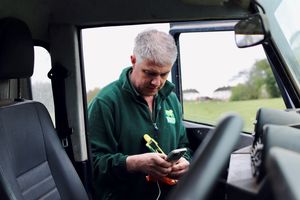Data management helps streamline Bridgnorth sheep farm
Bridgnorth-based sheep farmer Hayden Woolley has overhauled his business by adopting data recording software that has led to a change of breeds.

Having grown his sheep enterprise over the last 25 years, up to 4,000 ewes, Mr Woolley was looking to monitor flock performance to help find a way to bring labour intensity and cost down, without sacrificing productivity.
In 2020, following advice from Marcus Bullock at Livestock Management Systems, he started using the iLivestock platform to provide detailed comparisons within the flock and breeds.
Mr Woolley already had a digital weigh crate and an EID reader, but purchased the eWeigh and software subscription which easily connected the weigh crate to his phone and iPad.
“Initially I was only collecting basic production data but was surprised how the information built up. Even though I was only recording the basics, such as scanning results, breed, age and weights,” he says.
Change of breeds
The information encouraged Mr Woolley to look carefully at his farming system and gave him the confidence needed to change breeds, ultimately fully switching to wool-shedding genetics.
With reduced need for management, valuable time was freed to start collecting detailed individual animal data, with around 2,000 ewes now performance recorded.
He says: “Each ewe is allocated a visual management tag corresponding to her EID, single sire mated, with lambs tagged as they’re born outdoors in April.
“We collect ewe weights at tupping and weaning, while tagged lambs with known parentage are weighed at eight weeks and weaning.
“This allows us to make comparisons under commercial farming conditions.”
Mr Woolley has found that, without significant impacts on performance, shedding sheep require less than half the labour of his previous traditional system.
“My original EasyCare ewes averaged 62kg, which almost matched the output figures of my original New Zealand Romneys. When you consider the time and management savings of the EasyCares, this was just too big to ignore,” he says.
In recent years, a mixture of shedding and non-shedding breeds from Australia and New Zealand have been trialled on-farm, recording and examining the results through iLivestock.
“It’s been easy to gather the data as we complete routine tasks, and I’m getting a true picture of the risks and benefits these different breeds offer,” says Mr Woolley.
“I’m also starting to identify maternal and terminal traits needed for my flock, and shedding sheep in general.”
He is particularly pleased with the performance of the NZ Wiltshires and NZ Texels he has imported. Both breeds seem to complement his foundation EasyCare ewes well.
“The Wiltshire offers maternal characteristics and is very similar to the Romney, but without the wool and work requirements, whereas the Texel adds terminal traits shedding sheep lack,” says Mr Woolley.
Simplifying movements
The farm’s summer grazing is split over six different holdings totalling 1,700 acres of owned and rented parkland, and sheep are sent out to graze on around 15 different arable farms over winter, meaning stock are constantly on the move.
Because of this, Mr Woolley explains keeping basic admin and movement records updated is a complicated and regular task, but the iLivestock farm software has digitised and simplified this.
“All the information I need to complete movement licenses is pre-populated in the movements section of the app, so licences only take moments to complete,” he says.
“My holdings, markets, vehicles, medicine stocks and customer locations are also saved in the app, making it easy to treat and move batches or individual animals.”
With all the flock’s data and administration now in one place, time lost to paperwork is significantly reduced, allowing more time to be spent on the farm.





